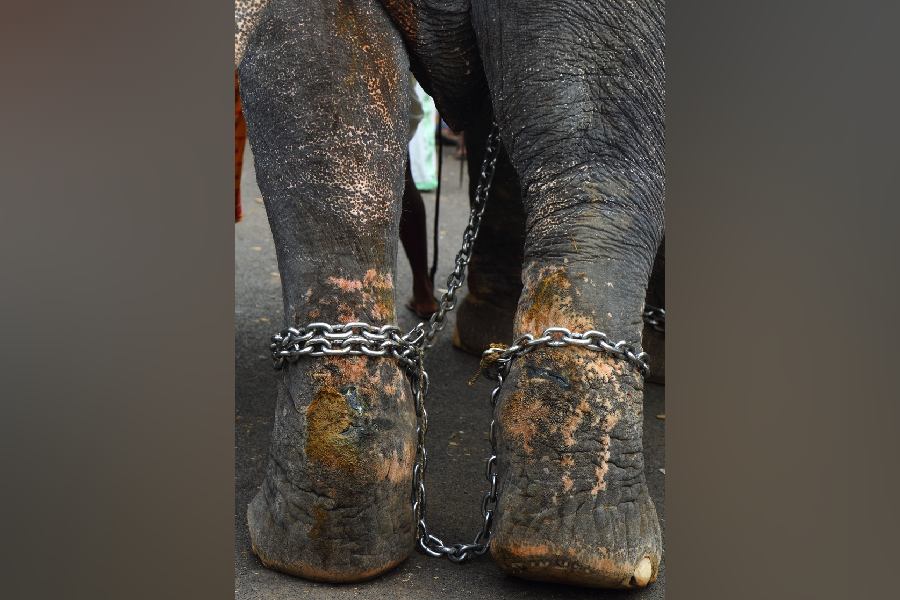|
|
When was the last time a new mishtir dokan opened near your house? Calcutta’s commercial landscape is growing by leaps and bounds, but are shops selling traditional Bengali sweets part of this growth? If this sounds too pessimistic for the Bengali new year, then let it be said that the run-up to Poila Baisakh is one of the brightest spots in the mishti-seller’s calendar, the others being Bijoya Dashami and Bhaiphonta. Doubters need only have looked at the crowds at the shops and the din emanating from them over the past week. Bad time to choose, therefore, for a recce of the traditional sweets of Bengal.
And what did a tour of some of the oldest Bengali sweet shops throw up? Mango rasogolla (K.C. Das), watermelon sandesh (Balaram Mullick), kiwifruit chhanar payesh (Nakur Nandy), chocolate jal-bhara (Makhan Lall Das) — and we haven’t even mentioned kaju barfi, pesta roll, besan laddu, gulab jamun (not to be confused with pantua) and other such imports from the western states. Some of the most-favoured sweets of the Bengalis today were not even a twinkle in their inventors’ eyes a decade ago. At Balaram Mullick & Radharaman Mullick in Bhowanipore, the sweet most in demand for Poila Baisakh was the kaju barfi. Sadhan Choudhury of Deshabandhu Mishtanna Bhandar in Burrabazar confirms that for festive occasions, Bengalis prefer the laddu these days.
What looks like the changing pattern of sweet consumption among Bengalis might actually be the most logical of progressions — though some would like to call it regression. To trace the course, one has to go back to the time when monda was the only kind of sweet available. While this dessert, created from almost equal proportions of sugar and milk, cannot be accused of making its consumers diabetic (no one has ever heard of a diabetic zamindar or nawab), the monda did provide the minor royals an excuse or two to quarrel (think of the angry babus of Sutanuti in Parashuram’s Birinchibaba). Possibly owing to a weakening of the Bengali sweet tooth, monda began to lose its popularity around the middle of the 19th century, which was also the time when some sweet-makers from Hooghly and Bardhaman moved to Calcutta. “From five powa (a quarter of a seer) in two seers of milk (5:8) for the hard monda, the proportion of sugar came down to six chhatak (one-sixteenth of a seer) in two-and-a-half seers of milk for the soft daana-pak kanchagolla,” I was informed by Shibnath Das, who now manages the shop in Chitpur’s Natunbajar founded in the late 19th century by his great grandfather, Makhan Lall Das. While the hardened sweet lived on in the kora-pak items like ratabi, ata-sandesh and jol-bhora, Bengalis took to the soft, medium-sweet, grainy or smooth, norom-pak sandesh with new vigour.
If change is the only constant, then what could be more natural than Balaram’s coming up with amrita-paturi (a mix of rasogolla, sandesh, rabri and nuts wrapped in banana leaf and fried in ghee) or K.C. Das with rasa-malancha (boiled malpoa wrapped around a stuffing of kheer or sandesh)? Sweet-makers, depending on whether you are accusing them of neglecting heritage or lauding their innovations, blame the Bengali’s constant demand for novelty or boast of their own genius. Only a few are willing to divulge more than that. Manjulika Das of K.C. Das explains the easy acceptance of “Bhujiawala” sweets among Bengalis in terms of the shelf-life advantage that these have over Bengali sweets.
And then there is the problem of the poor quality of milk. While all the big sweet-manufacturers profess a “no compromise” stand on this, and some even claim to source milk from exclusive farms, nearly all the old-timers agree that the milk they get now leaves much to be desired. The ‘external’ (read Marwari) influence is squarely blamed for the entry of buffalo-milk into the sacred ‘Bengali’ domain of the lighter and sweeter cow-milk. Ask which kind of milk they use for their sweets, and watch the suave, confident proprietors of renowned sweet shops go on the defensive. While most use a combination of the two because it is just not economically viable to work with cow-milk alone, few — Balaram’s is an exception in this — are willing to own up to the fact. Shibnath Das insists that the quality of their chhana tells the seasoned sandesh-eater what milk has been used.
Rasogolla is one sweet for which there is no alternative to cow-milk. Or so says Nitaibabu, of Chittaranjan of Shyambazar, whose rasogolla “did not need to travel in tins to gain a following”. Rasogolla is perhaps also the sweet that has been subjected to the largest number of experiments. Name a flavour and it is most likely that some shop in the city will have a rasogolla of that flavour. Chittaranjan looks down on these shops, and on those who claim to have successfully mechanized the rasogolla-making process. “A rasogolla does not become one without the human touch,” says Nitaibabu. You would feel inclined to disbelieve him if you saw the “rasogolla-machine” that Balaram’s has installed recently. Its operation reminds you of Modern Times — a giant “planetary mixer” blending the chhana into a smooth paste before the dough is fed into the next gadget, which cuts it up into little pieces that move down a conveyer belt and pass underneath a rotating steel plate shaping them into balls. A tray placed at the end of the belt collects the balls, which then land straight into kadais of boiling sugar syrup.
It is interesting that Balaram’s is located in the South. Sweet-shops, like life in Calcutta, have taken the southern route to swankyness; first they travelled from the districts to the city, then from the north of the city to the south. At Makhan Lall Das, or at Nakur Nandy, neither the owners nor the loyal clientele feel a need to spruce things up or start new outlets in the more happening localities (though their prices have kept pace with the market). As two karigars (the closest English word to this would be ‘craftsmen’) deftly create telak and jol-bhora sandesh on the platform next to his, Shibnath Das talks about his plans of air-conditioning a part of his shop, if only to keep the flies away. Selling laddu or idli from a traditional sweet shop is sheer philistinism, but Das sees nothing wrong in accepting credit cards (till recently, trying to use a card in a North Calcutta sweet shop would have made one a laughing stock), or offering delivery services, or launching a website. Some of the changes bear the stamp of new blood. Youngsters who have chosen to get involved in the family trade, like Sudip Mullick of Balaram’s and Shibnath Das’s nephew, have brought in fresh ideas for marketing, just as their fathers had improvised on old sweets. But the reason why new mishti-shops are hard to come by is that the young generation is not too keen on sticking to the sweet trade.
Which is a bigger threat to the traditional Bengali sandesh and rasogolla — the calorie-conscious, sweet-shunning young people, or the ‘foreign imports’? Some feel that the mishti is trying too hard to create the likes of cake, pastry and mousse — presumably to attract youngsters. Hence the use of fresh cream, chocolate and fruit preserves in the ‘new discoveries’. The flourishing business of Haldiram’s and Gupta Brothers indicates that an increasing number of Bengalis are patronizing them, just as rich Marwari patrons had once revived the fortunes of modest sweet shops in the North. The old-world sandesh has, by now, got used to sharing its glass case with the kaju barfi and hybrid sweets. But why is it so hard to imagine a traditional mishtanna bhandar in the South City mall?











